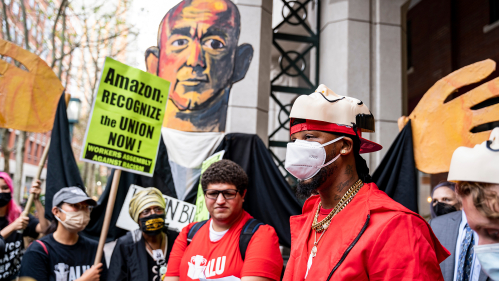Why Unions Are Cool Again

An upstart, independent labor union rocked corporate America in April by successfully organizing an Amazon warehouse for the first time. They’re hoping lightning strikes twice. This week, workers at an Amazon facility near Albany, New York are voting on whether to join the same union.
Amazon Labor Union’s success is part of a resurgent year for the labor movement, also highlighted by the first unionized Apple Store, Chipotle and Trader Joe’s, and more than 200 unionized Starbucks stores. Thousands of nurses and teachers have gone on strike. And public support for unions stands at 71 percent, the highest approval rating since 1965.
Rebecca Kolins Givan breaks down the latest developments as the first guest on the debut episode of A Third of Your Life, the new podcast from the School of Management and Labor Relations, where Givan is a professor. The monthly show examines the tech, trends and controversies that are reshaping the place where we spend a third of our lives: work.
The following is an abridged transcript of the episode.
What is going on in the American workplace? Why is all of this happening now?
I think there's a few things that have led us to this moment. I think working through the pandemic, a lot of people felt like their bosses didn't care about them, didn't handle the pandemic well, whether we're talking about health and safety issues or battles over remote work versus returning to the office. A lot of people had new insight into whether their employer cared about them at all. And that's been coupled with a very tight labor market where it's easy for workers to leave and go get a job somewhere else. And when they're thinking about organizing rather than leaving, when they don't have to fear losing their job because they know it's pretty easy to go and find another job, that changes the calculation and makes workers more likely to organize.
What do you expect will happen with the Amazon union election this week in Upstate New York?
It's hard to predict, but the odds are always stacked against the union. These are very, very high turnover workplaces where most workers don't stick around long enough to form strong relationships with each other, and they're facing an all-out assault in terms of the anti-union campaign that they hear from the employer. Amazon has mandatory meetings they hold them all day long. Most workers will listen to multiple sessions of about a half an hour a piece telling them why they should be fearful of unionizing, telling them that there are a lot of downsides, trying to sow fear, uncertainty, and doubt in their minds. It's very, very difficult to have a successful organizing drive in an atmosphere like that.
Let's talk about Starbucks now. More than 200 unionized Starbucks stores all across the country. A huge number. Did you see that coming?
I don't think anybody saw it coming. I certainly didn't see it coming. It's very impressive to organize so many separate workplaces and sort of really build this powerful wave.
And yet against the backdrop of those successes, we're hearing more and more about allegations of union busting. Starbucks Workers United says the company has fired dozens of union leaders. If that allegation is true, how do they get away with it? And is it scaring off workers in other stores who may be thinking of organizing?
I'm sure the intended effect is to scare workers and to create a sort of chilling effect so workers are less inclined to organize. The problem with current labor law is that it's very slow and the National Labor Relations Board, that administers the law, is really underfunded and understaffed. So, it's hard to move quickly on allegations like this.
If Starbucks is in fact found to have illegally fired these workers that were organizing, the penalty they pay will be relatively minimal, essentially reinstating the workers with back pay for the time they were away. That's not really a significant enough penalty to deter them from doing it again. If it creates a chilling effect successfully, they may decide to keep on doing it. And even if they lose those legal cases, that might be a price they're willing to pay.
When the story of this period is written, when historians and future professors look back on what happened in the labor movement between 2018 and 2022, what will resonate the most? What will students be learning about this moment in the history of work?
I think one of the things that will be most significant will be young workers organizing. So, some of these big victories, especially in places like Starbucks and Amazon, are really led by young workers who are excited to improve their working conditions, are excited to organize, are learning about the nuts and bolts of organizing, and that energy and those skills are really spreading. So I think the importance of young workers in this moment is really going to have a lasting impact.
Click here to listen to the full episode on your favorite podcast platform.


